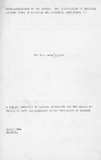| dc.description.abstract | This study presents a site oriented study of Gabbra
material culture and its distribution in different settlements.
It is based on observations made in inhabited and
abandoned settlements and on the material remains excavated
from the latter by the author in December and January 1981.
In the inhabited settlements (OlIa), the various
settlement structures and their relative locations were
recorded and a complete inventory was made of all traditional
material culture items including their names, uses,
raw materials for manufacture and where obtained, their
makers (men/women, young/adult), where kept, where used
and where finally discarded when no longer serving the
purposes for which they were made. The different activities
carried out in the settlement were also observed,
together with the areas involved, the reasons for using these particular areas and the material remains which the
activities may generate.
In the abandoned settlements (Onna) , observations
were made of the nature and distribution of cultural
material remains, the state of settlements and their
structures for purposes of identifying activities and
activity areas. These yielded a few materials such as
food debris, and material culture objects that were no
longer in use.
Observations showed that, although this society has
very many material culture items used in performing
diverse activities that take place in different activity
areas, few of them are left behind in the area of usage
once they wear out, break or cease to perform functions
for which they were made. The majority are discarded
elsewhere and even then there is a tendency for archaeological
site disturbing agents to relocate them a
phenomenon that was confirmed in visited.
The few remains found undisturbed were complete
hearths, from which one cannot only deduce the number of
huts a settlement contained and their positions but also
one activity area - that of food preparation. The rest
of the activities may not be reconstructable. The same
may be said of other pastoral societies in the past and
the present. | en |

